Occupational Hygiene, Health and Ergonomics: Tesla Motors
VerifiedAdded on 2023/01/13
|10
|3016
|98
Report
AI Summary
This report delves into the multifaceted field of occupational hygiene, health, and ergonomics, with a specific focus on the application within Tesla Motors. It begins by exploring legislative controls, including the role of Work Exposure Limits (WELs) and various mechanisms for both personal and environmental monitoring. The report then transitions to an examination of the role of toxicological and epidemiological data sets in developing standards for occupational health and safety. It covers the Health and Safety at Work Act 1974, the Health and Safety Consultation with employees Regulations 1996, and the Management of Health and Safety at Work Regulations 1999, as well as the responsibilities of workers and employers. The report also discusses the importance of WELs in providing healthcare benefits and outlines the mechanisms for monitoring health and hygiene, including sanitation monitoring and the selection methods for environmental monitoring. Finally, the report analyzes the application of toxicology and epidemiology in the workplace, emphasizing their roles in identifying and mitigating health risks associated with chemical, biological, and physical hazards. The report highlights the importance of data in understanding disease progression and building statistical models, with challenges in data presentation and accessibility.
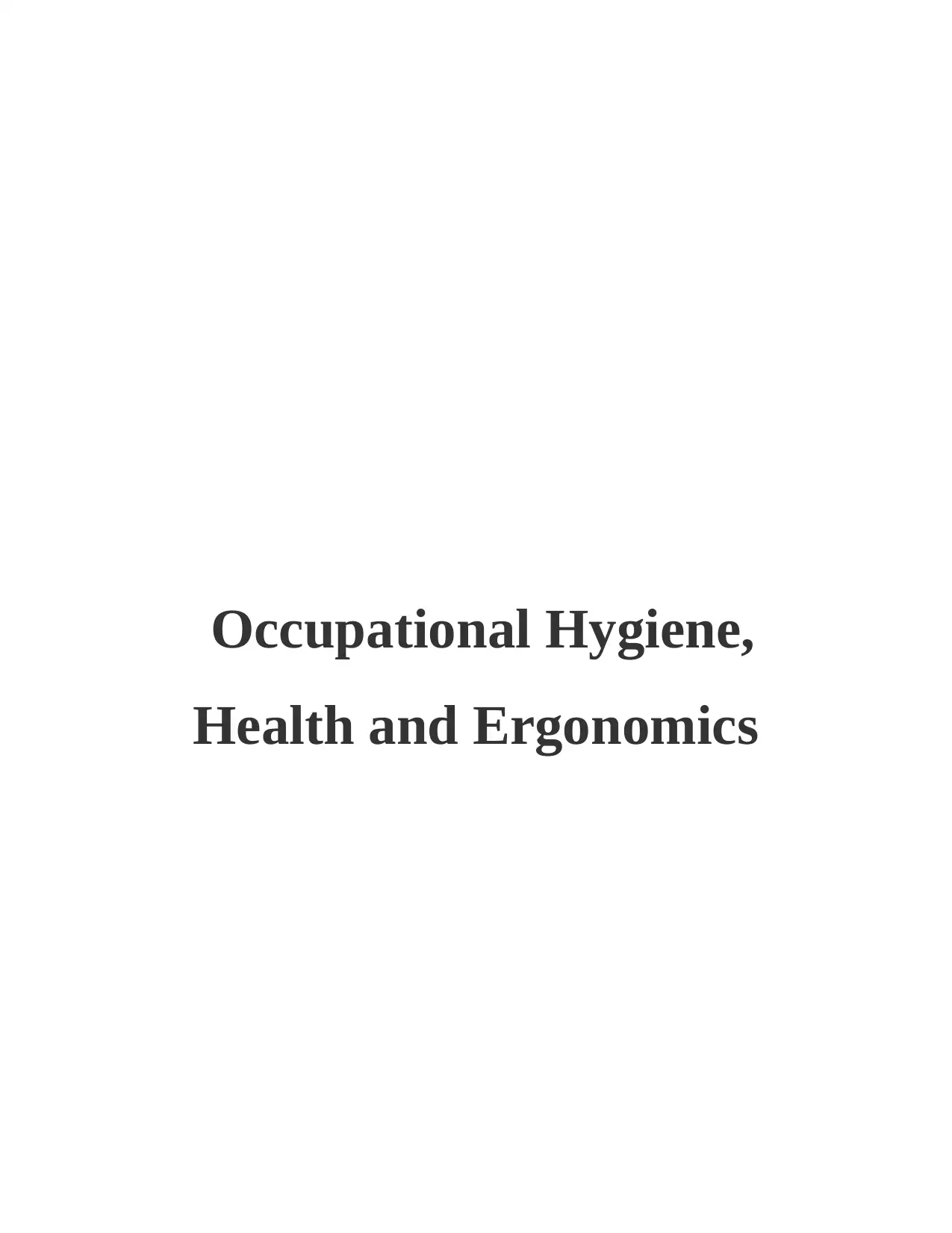
Occupational Hygiene,
Health and Ergonomics
Health and Ergonomics
Paraphrase This Document
Need a fresh take? Get an instant paraphrase of this document with our AI Paraphraser
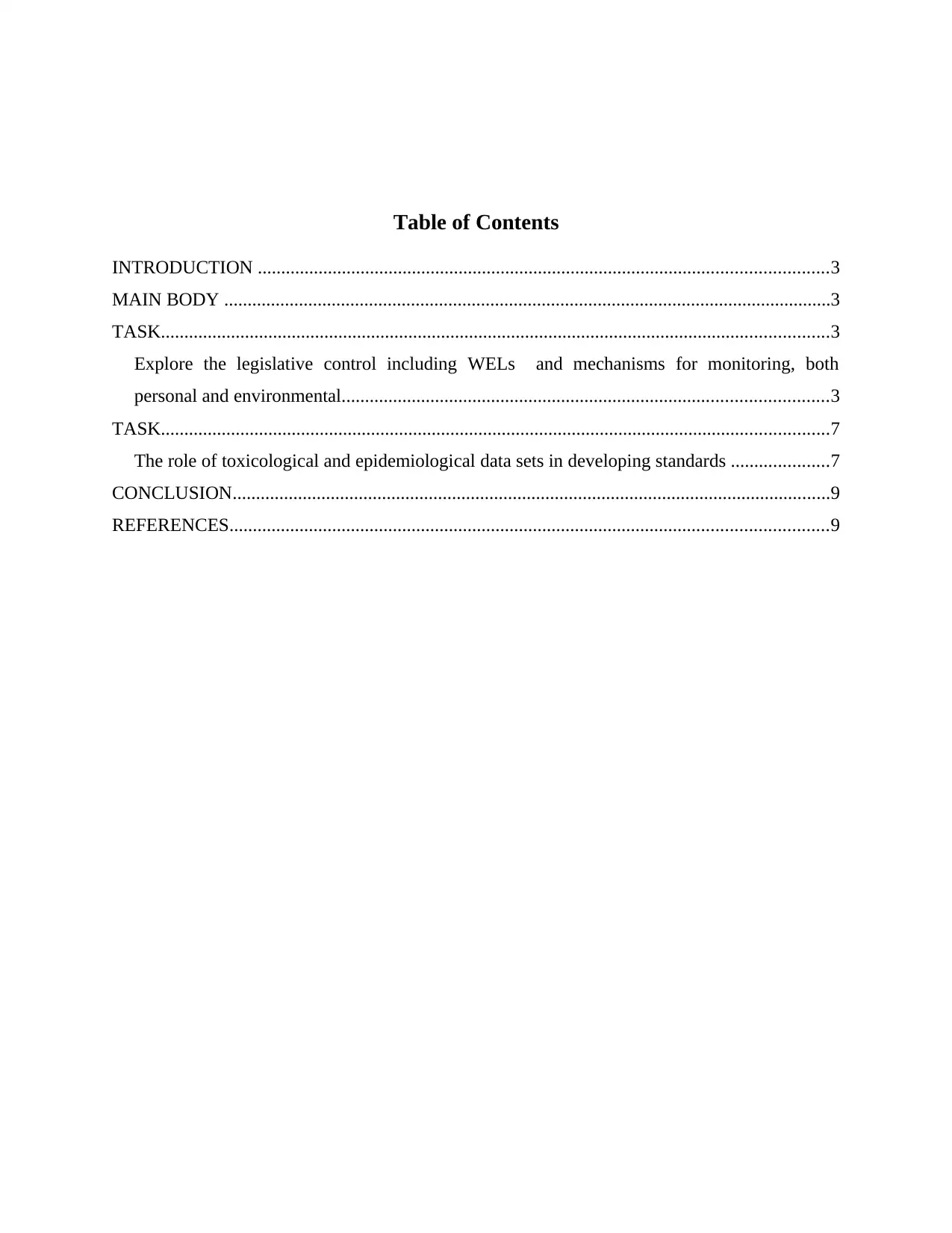
Table of Contents
INTRODUCTION ..........................................................................................................................3
MAIN BODY ..................................................................................................................................3
TASK...............................................................................................................................................3
Explore the legislative control including WELs and mechanisms for monitoring, both
personal and environmental........................................................................................................3
TASK...............................................................................................................................................7
The role of toxicological and epidemiological data sets in developing standards .....................7
CONCLUSION................................................................................................................................9
REFERENCES................................................................................................................................9
INTRODUCTION ..........................................................................................................................3
MAIN BODY ..................................................................................................................................3
TASK...............................................................................................................................................3
Explore the legislative control including WELs and mechanisms for monitoring, both
personal and environmental........................................................................................................3
TASK...............................................................................................................................................7
The role of toxicological and epidemiological data sets in developing standards .....................7
CONCLUSION................................................................................................................................9
REFERENCES................................................................................................................................9
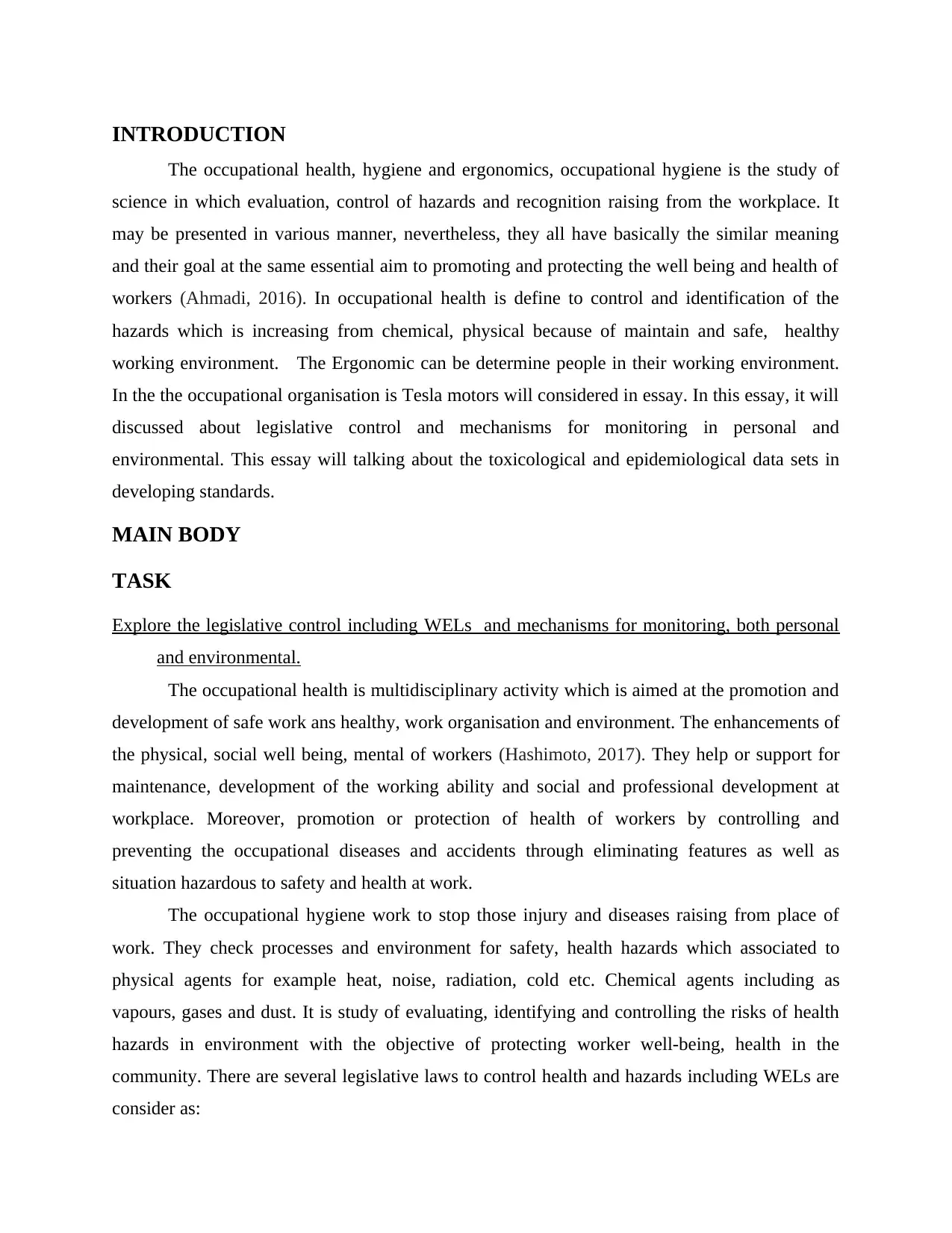
INTRODUCTION
The occupational health, hygiene and ergonomics, occupational hygiene is the study of
science in which evaluation, control of hazards and recognition raising from the workplace. It
may be presented in various manner, nevertheless, they all have basically the similar meaning
and their goal at the same essential aim to promoting and protecting the well being and health of
workers (Ahmadi, 2016). In occupational health is define to control and identification of the
hazards which is increasing from chemical, physical because of maintain and safe, healthy
working environment. The Ergonomic can be determine people in their working environment.
In the the occupational organisation is Tesla motors will considered in essay. In this essay, it will
discussed about legislative control and mechanisms for monitoring in personal and
environmental. This essay will talking about the toxicological and epidemiological data sets in
developing standards.
MAIN BODY
TASK
Explore the legislative control including WELs and mechanisms for monitoring, both personal
and environmental.
The occupational health is multidisciplinary activity which is aimed at the promotion and
development of safe work ans healthy, work organisation and environment. The enhancements of
the physical, social well being, mental of workers (Hashimoto, 2017). They help or support for
maintenance, development of the working ability and social and professional development at
workplace. Moreover, promotion or protection of health of workers by controlling and
preventing the occupational diseases and accidents through eliminating features as well as
situation hazardous to safety and health at work.
The occupational hygiene work to stop those injury and diseases raising from place of
work. They check processes and environment for safety, health hazards which associated to
physical agents for example heat, noise, radiation, cold etc. Chemical agents including as
vapours, gases and dust. It is study of evaluating, identifying and controlling the risks of health
hazards in environment with the objective of protecting worker well-being, health in the
community. There are several legislative laws to control health and hazards including WELs are
consider as:
The occupational health, hygiene and ergonomics, occupational hygiene is the study of
science in which evaluation, control of hazards and recognition raising from the workplace. It
may be presented in various manner, nevertheless, they all have basically the similar meaning
and their goal at the same essential aim to promoting and protecting the well being and health of
workers (Ahmadi, 2016). In occupational health is define to control and identification of the
hazards which is increasing from chemical, physical because of maintain and safe, healthy
working environment. The Ergonomic can be determine people in their working environment.
In the the occupational organisation is Tesla motors will considered in essay. In this essay, it will
discussed about legislative control and mechanisms for monitoring in personal and
environmental. This essay will talking about the toxicological and epidemiological data sets in
developing standards.
MAIN BODY
TASK
Explore the legislative control including WELs and mechanisms for monitoring, both personal
and environmental.
The occupational health is multidisciplinary activity which is aimed at the promotion and
development of safe work ans healthy, work organisation and environment. The enhancements of
the physical, social well being, mental of workers (Hashimoto, 2017). They help or support for
maintenance, development of the working ability and social and professional development at
workplace. Moreover, promotion or protection of health of workers by controlling and
preventing the occupational diseases and accidents through eliminating features as well as
situation hazardous to safety and health at work.
The occupational hygiene work to stop those injury and diseases raising from place of
work. They check processes and environment for safety, health hazards which associated to
physical agents for example heat, noise, radiation, cold etc. Chemical agents including as
vapours, gases and dust. It is study of evaluating, identifying and controlling the risks of health
hazards in environment with the objective of protecting worker well-being, health in the
community. There are several legislative laws to control health and hazards including WELs are
consider as:
⊘ This is a preview!⊘
Do you want full access?
Subscribe today to unlock all pages.

Trusted by 1+ million students worldwide
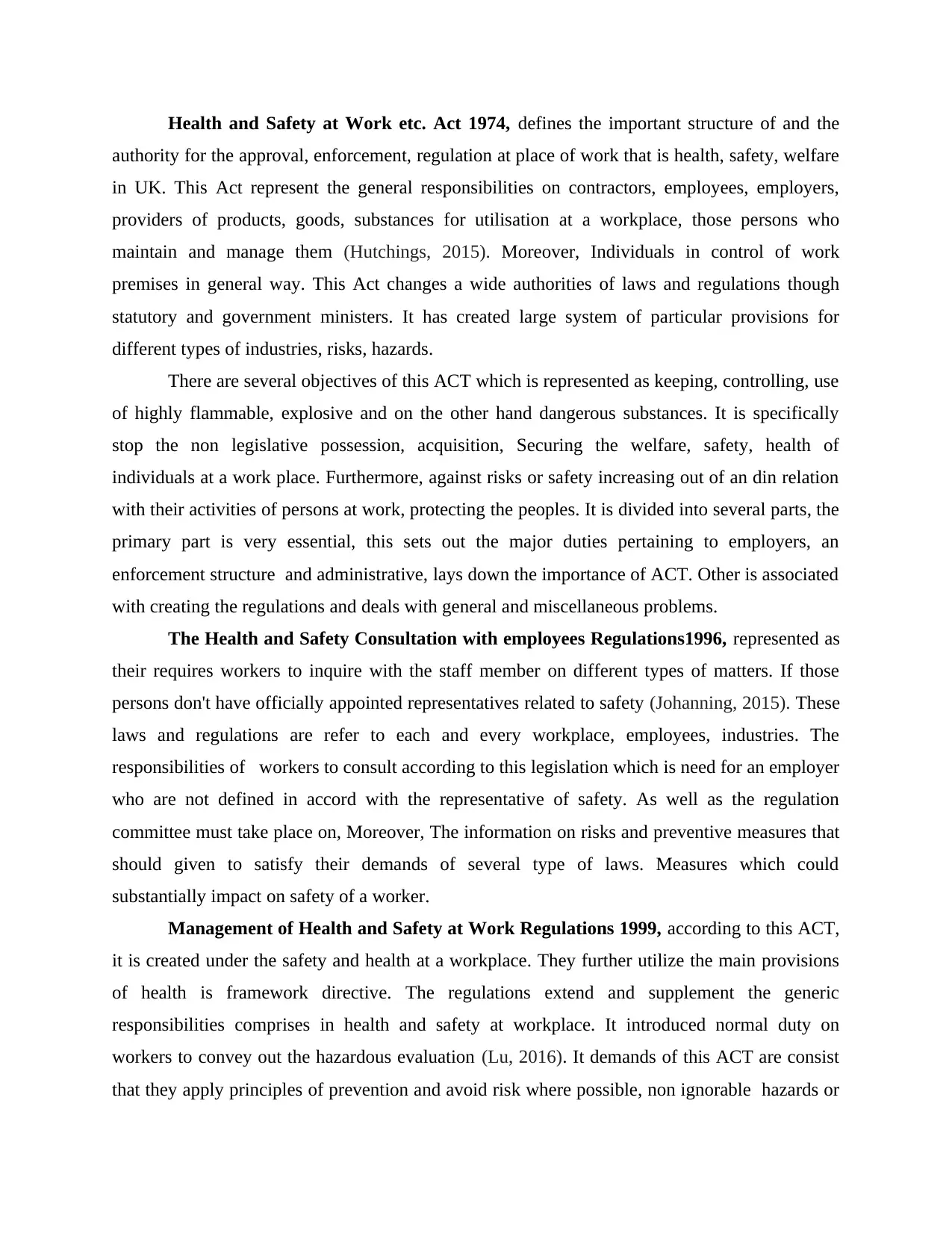
Health and Safety at Work etc. Act 1974, defines the important structure of and the
authority for the approval, enforcement, regulation at place of work that is health, safety, welfare
in UK. This Act represent the general responsibilities on contractors, employees, employers,
providers of products, goods, substances for utilisation at a workplace, those persons who
maintain and manage them (Hutchings, 2015). Moreover, Individuals in control of work
premises in general way. This Act changes a wide authorities of laws and regulations though
statutory and government ministers. It has created large system of particular provisions for
different types of industries, risks, hazards.
There are several objectives of this ACT which is represented as keeping, controlling, use
of highly flammable, explosive and on the other hand dangerous substances. It is specifically
stop the non legislative possession, acquisition, Securing the welfare, safety, health of
individuals at a work place. Furthermore, against risks or safety increasing out of an din relation
with their activities of persons at work, protecting the peoples. It is divided into several parts, the
primary part is very essential, this sets out the major duties pertaining to employers, an
enforcement structure and administrative, lays down the importance of ACT. Other is associated
with creating the regulations and deals with general and miscellaneous problems.
The Health and Safety Consultation with employees Regulations1996, represented as
their requires workers to inquire with the staff member on different types of matters. If those
persons don't have officially appointed representatives related to safety (Johanning, 2015). These
laws and regulations are refer to each and every workplace, employees, industries. The
responsibilities of workers to consult according to this legislation which is need for an employer
who are not defined in accord with the representative of safety. As well as the regulation
committee must take place on, Moreover, The information on risks and preventive measures that
should given to satisfy their demands of several type of laws. Measures which could
substantially impact on safety of a worker.
Management of Health and Safety at Work Regulations 1999, according to this ACT,
it is created under the safety and health at a workplace. They further utilize the main provisions
of health is framework directive. The regulations extend and supplement the generic
responsibilities comprises in health and safety at workplace. It introduced normal duty on
workers to convey out the hazardous evaluation (Lu, 2016). It demands of this ACT are consist
that they apply principles of prevention and avoid risk where possible, non ignorable hazards or
authority for the approval, enforcement, regulation at place of work that is health, safety, welfare
in UK. This Act represent the general responsibilities on contractors, employees, employers,
providers of products, goods, substances for utilisation at a workplace, those persons who
maintain and manage them (Hutchings, 2015). Moreover, Individuals in control of work
premises in general way. This Act changes a wide authorities of laws and regulations though
statutory and government ministers. It has created large system of particular provisions for
different types of industries, risks, hazards.
There are several objectives of this ACT which is represented as keeping, controlling, use
of highly flammable, explosive and on the other hand dangerous substances. It is specifically
stop the non legislative possession, acquisition, Securing the welfare, safety, health of
individuals at a work place. Furthermore, against risks or safety increasing out of an din relation
with their activities of persons at work, protecting the peoples. It is divided into several parts, the
primary part is very essential, this sets out the major duties pertaining to employers, an
enforcement structure and administrative, lays down the importance of ACT. Other is associated
with creating the regulations and deals with general and miscellaneous problems.
The Health and Safety Consultation with employees Regulations1996, represented as
their requires workers to inquire with the staff member on different types of matters. If those
persons don't have officially appointed representatives related to safety (Johanning, 2015). These
laws and regulations are refer to each and every workplace, employees, industries. The
responsibilities of workers to consult according to this legislation which is need for an employer
who are not defined in accord with the representative of safety. As well as the regulation
committee must take place on, Moreover, The information on risks and preventive measures that
should given to satisfy their demands of several type of laws. Measures which could
substantially impact on safety of a worker.
Management of Health and Safety at Work Regulations 1999, according to this ACT,
it is created under the safety and health at a workplace. They further utilize the main provisions
of health is framework directive. The regulations extend and supplement the generic
responsibilities comprises in health and safety at workplace. It introduced normal duty on
workers to convey out the hazardous evaluation (Lu, 2016). It demands of this ACT are consist
that they apply principles of prevention and avoid risk where possible, non ignorable hazards or
Paraphrase This Document
Need a fresh take? Get an instant paraphrase of this document with our AI Paraphraser
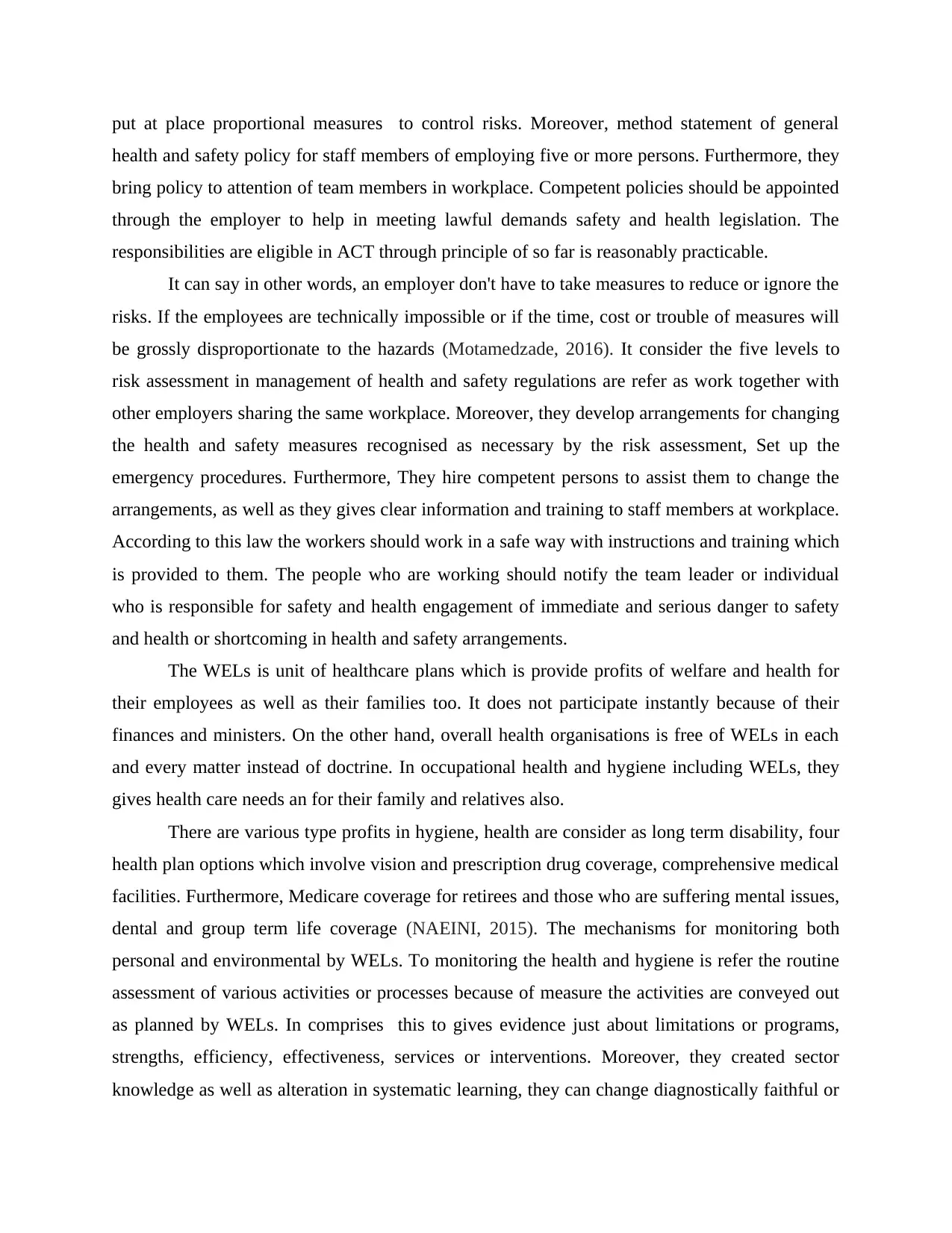
put at place proportional measures to control risks. Moreover, method statement of general
health and safety policy for staff members of employing five or more persons. Furthermore, they
bring policy to attention of team members in workplace. Competent policies should be appointed
through the employer to help in meeting lawful demands safety and health legislation. The
responsibilities are eligible in ACT through principle of so far is reasonably practicable.
It can say in other words, an employer don't have to take measures to reduce or ignore the
risks. If the employees are technically impossible or if the time, cost or trouble of measures will
be grossly disproportionate to the hazards (Motamedzade, 2016). It consider the five levels to
risk assessment in management of health and safety regulations are refer as work together with
other employers sharing the same workplace. Moreover, they develop arrangements for changing
the health and safety measures recognised as necessary by the risk assessment, Set up the
emergency procedures. Furthermore, They hire competent persons to assist them to change the
arrangements, as well as they gives clear information and training to staff members at workplace.
According to this law the workers should work in a safe way with instructions and training which
is provided to them. The people who are working should notify the team leader or individual
who is responsible for safety and health engagement of immediate and serious danger to safety
and health or shortcoming in health and safety arrangements.
The WELs is unit of healthcare plans which is provide profits of welfare and health for
their employees as well as their families too. It does not participate instantly because of their
finances and ministers. On the other hand, overall health organisations is free of WELs in each
and every matter instead of doctrine. In occupational health and hygiene including WELs, they
gives health care needs an for their family and relatives also.
There are various type profits in hygiene, health are consider as long term disability, four
health plan options which involve vision and prescription drug coverage, comprehensive medical
facilities. Furthermore, Medicare coverage for retirees and those who are suffering mental issues,
dental and group term life coverage (NAEINI, 2015). The mechanisms for monitoring both
personal and environmental by WELs. To monitoring the health and hygiene is refer the routine
assessment of various activities or processes because of measure the activities are conveyed out
as planned by WELs. In comprises this to gives evidence just about limitations or programs,
strengths, efficiency, effectiveness, services or interventions. Moreover, they created sector
knowledge as well as alteration in systematic learning, they can change diagnostically faithful or
health and safety policy for staff members of employing five or more persons. Furthermore, they
bring policy to attention of team members in workplace. Competent policies should be appointed
through the employer to help in meeting lawful demands safety and health legislation. The
responsibilities are eligible in ACT through principle of so far is reasonably practicable.
It can say in other words, an employer don't have to take measures to reduce or ignore the
risks. If the employees are technically impossible or if the time, cost or trouble of measures will
be grossly disproportionate to the hazards (Motamedzade, 2016). It consider the five levels to
risk assessment in management of health and safety regulations are refer as work together with
other employers sharing the same workplace. Moreover, they develop arrangements for changing
the health and safety measures recognised as necessary by the risk assessment, Set up the
emergency procedures. Furthermore, They hire competent persons to assist them to change the
arrangements, as well as they gives clear information and training to staff members at workplace.
According to this law the workers should work in a safe way with instructions and training which
is provided to them. The people who are working should notify the team leader or individual
who is responsible for safety and health engagement of immediate and serious danger to safety
and health or shortcoming in health and safety arrangements.
The WELs is unit of healthcare plans which is provide profits of welfare and health for
their employees as well as their families too. It does not participate instantly because of their
finances and ministers. On the other hand, overall health organisations is free of WELs in each
and every matter instead of doctrine. In occupational health and hygiene including WELs, they
gives health care needs an for their family and relatives also.
There are various type profits in hygiene, health are consider as long term disability, four
health plan options which involve vision and prescription drug coverage, comprehensive medical
facilities. Furthermore, Medicare coverage for retirees and those who are suffering mental issues,
dental and group term life coverage (NAEINI, 2015). The mechanisms for monitoring both
personal and environmental by WELs. To monitoring the health and hygiene is refer the routine
assessment of various activities or processes because of measure the activities are conveyed out
as planned by WELs. In comprises this to gives evidence just about limitations or programs,
strengths, efficiency, effectiveness, services or interventions. Moreover, they created sector
knowledge as well as alteration in systematic learning, they can change diagnostically faithful or
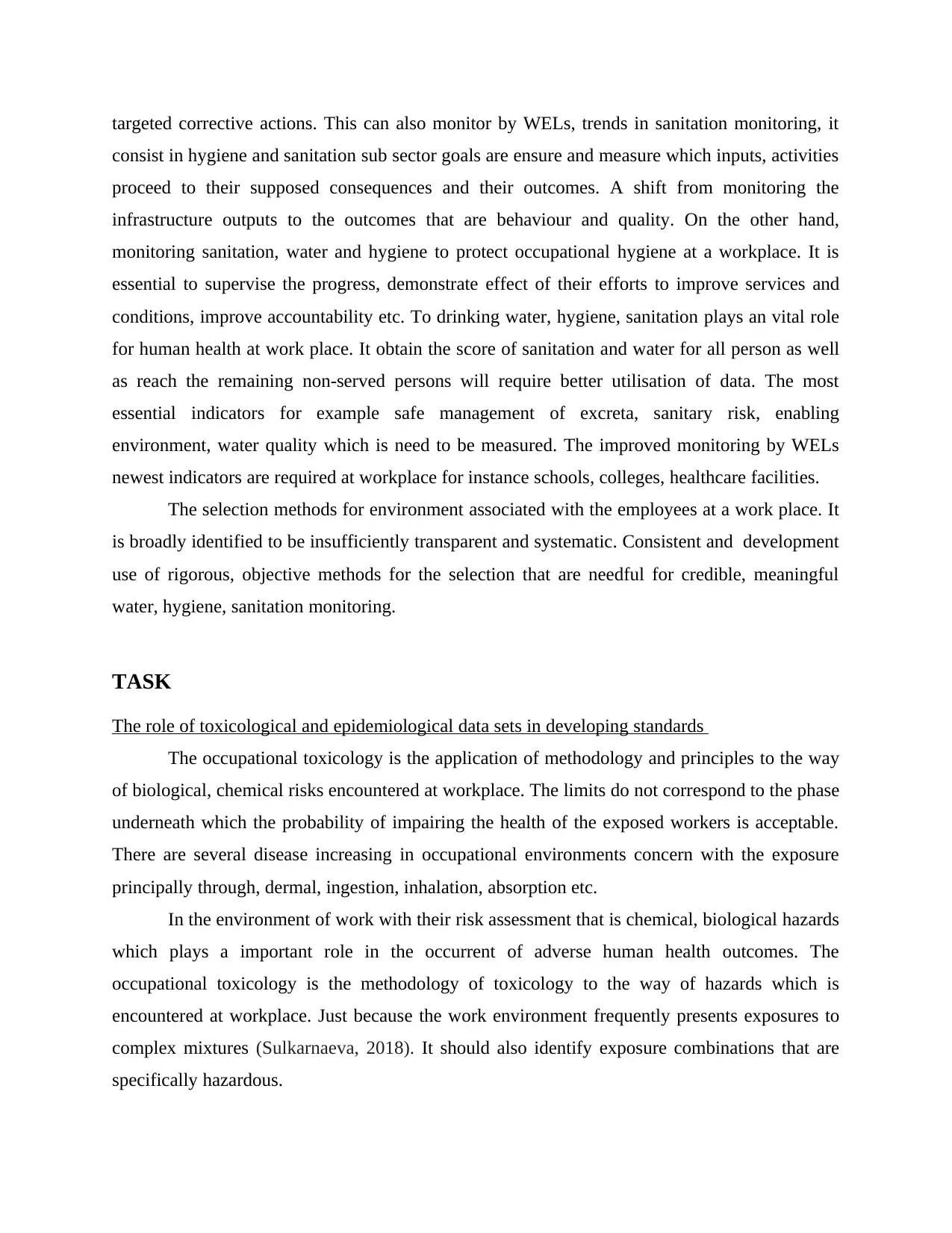
targeted corrective actions. This can also monitor by WELs, trends in sanitation monitoring, it
consist in hygiene and sanitation sub sector goals are ensure and measure which inputs, activities
proceed to their supposed consequences and their outcomes. A shift from monitoring the
infrastructure outputs to the outcomes that are behaviour and quality. On the other hand,
monitoring sanitation, water and hygiene to protect occupational hygiene at a workplace. It is
essential to supervise the progress, demonstrate effect of their efforts to improve services and
conditions, improve accountability etc. To drinking water, hygiene, sanitation plays an vital role
for human health at work place. It obtain the score of sanitation and water for all person as well
as reach the remaining non-served persons will require better utilisation of data. The most
essential indicators for example safe management of excreta, sanitary risk, enabling
environment, water quality which is need to be measured. The improved monitoring by WELs
newest indicators are required at workplace for instance schools, colleges, healthcare facilities.
The selection methods for environment associated with the employees at a work place. It
is broadly identified to be insufficiently transparent and systematic. Consistent and development
use of rigorous, objective methods for the selection that are needful for credible, meaningful
water, hygiene, sanitation monitoring.
TASK
The role of toxicological and epidemiological data sets in developing standards
The occupational toxicology is the application of methodology and principles to the way
of biological, chemical risks encountered at workplace. The limits do not correspond to the phase
underneath which the probability of impairing the health of the exposed workers is acceptable.
There are several disease increasing in occupational environments concern with the exposure
principally through, dermal, ingestion, inhalation, absorption etc.
In the environment of work with their risk assessment that is chemical, biological hazards
which plays a important role in the occurrent of adverse human health outcomes. The
occupational toxicology is the methodology of toxicology to the way of hazards which is
encountered at workplace. Just because the work environment frequently presents exposures to
complex mixtures (Sulkarnaeva, 2018). It should also identify exposure combinations that are
specifically hazardous.
consist in hygiene and sanitation sub sector goals are ensure and measure which inputs, activities
proceed to their supposed consequences and their outcomes. A shift from monitoring the
infrastructure outputs to the outcomes that are behaviour and quality. On the other hand,
monitoring sanitation, water and hygiene to protect occupational hygiene at a workplace. It is
essential to supervise the progress, demonstrate effect of their efforts to improve services and
conditions, improve accountability etc. To drinking water, hygiene, sanitation plays an vital role
for human health at work place. It obtain the score of sanitation and water for all person as well
as reach the remaining non-served persons will require better utilisation of data. The most
essential indicators for example safe management of excreta, sanitary risk, enabling
environment, water quality which is need to be measured. The improved monitoring by WELs
newest indicators are required at workplace for instance schools, colleges, healthcare facilities.
The selection methods for environment associated with the employees at a work place. It
is broadly identified to be insufficiently transparent and systematic. Consistent and development
use of rigorous, objective methods for the selection that are needful for credible, meaningful
water, hygiene, sanitation monitoring.
TASK
The role of toxicological and epidemiological data sets in developing standards
The occupational toxicology is the application of methodology and principles to the way
of biological, chemical risks encountered at workplace. The limits do not correspond to the phase
underneath which the probability of impairing the health of the exposed workers is acceptable.
There are several disease increasing in occupational environments concern with the exposure
principally through, dermal, ingestion, inhalation, absorption etc.
In the environment of work with their risk assessment that is chemical, biological hazards
which plays a important role in the occurrent of adverse human health outcomes. The
occupational toxicology is the methodology of toxicology to the way of hazards which is
encountered at workplace. Just because the work environment frequently presents exposures to
complex mixtures (Sulkarnaeva, 2018). It should also identify exposure combinations that are
specifically hazardous.
⊘ This is a preview!⊘
Do you want full access?
Subscribe today to unlock all pages.

Trusted by 1+ million students worldwide
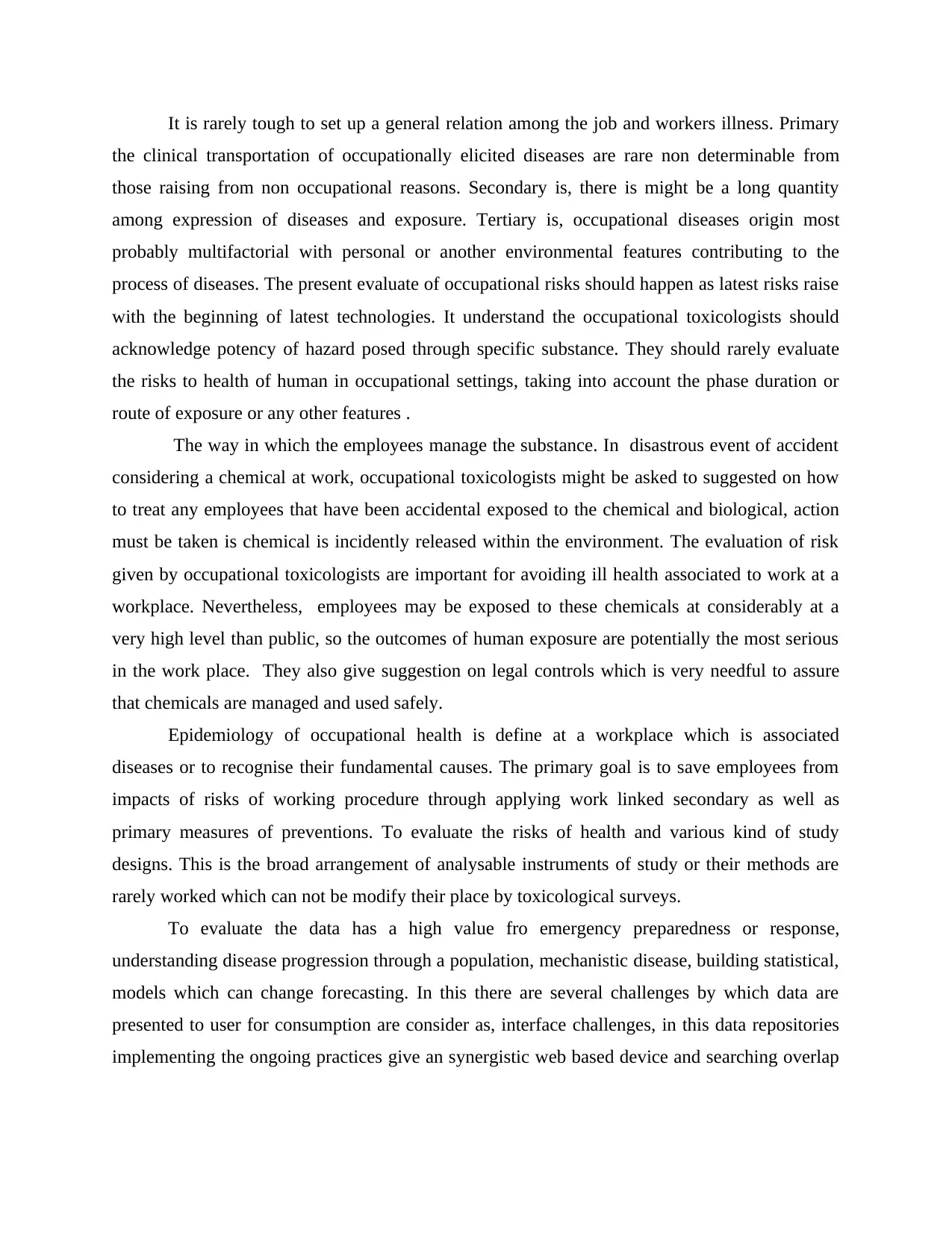
It is rarely tough to set up a general relation among the job and workers illness. Primary
the clinical transportation of occupationally elicited diseases are rare non determinable from
those raising from non occupational reasons. Secondary is, there is might be a long quantity
among expression of diseases and exposure. Tertiary is, occupational diseases origin most
probably multifactorial with personal or another environmental features contributing to the
process of diseases. The present evaluate of occupational risks should happen as latest risks raise
with the beginning of latest technologies. It understand the occupational toxicologists should
acknowledge potency of hazard posed through specific substance. They should rarely evaluate
the risks to health of human in occupational settings, taking into account the phase duration or
route of exposure or any other features .
The way in which the employees manage the substance. In disastrous event of accident
considering a chemical at work, occupational toxicologists might be asked to suggested on how
to treat any employees that have been accidental exposed to the chemical and biological, action
must be taken is chemical is incidently released within the environment. The evaluation of risk
given by occupational toxicologists are important for avoiding ill health associated to work at a
workplace. Nevertheless, employees may be exposed to these chemicals at considerably at a
very high level than public, so the outcomes of human exposure are potentially the most serious
in the work place. They also give suggestion on legal controls which is very needful to assure
that chemicals are managed and used safely.
Epidemiology of occupational health is define at a workplace which is associated
diseases or to recognise their fundamental causes. The primary goal is to save employees from
impacts of risks of working procedure through applying work linked secondary as well as
primary measures of preventions. To evaluate the risks of health and various kind of study
designs. This is the broad arrangement of analysable instruments of study or their methods are
rarely worked which can not be modify their place by toxicological surveys.
To evaluate the data has a high value fro emergency preparedness or response,
understanding disease progression through a population, mechanistic disease, building statistical,
models which can change forecasting. In this there are several challenges by which data are
presented to user for consumption are consider as, interface challenges, in this data repositories
implementing the ongoing practices give an synergistic web based device and searching overlap
the clinical transportation of occupationally elicited diseases are rare non determinable from
those raising from non occupational reasons. Secondary is, there is might be a long quantity
among expression of diseases and exposure. Tertiary is, occupational diseases origin most
probably multifactorial with personal or another environmental features contributing to the
process of diseases. The present evaluate of occupational risks should happen as latest risks raise
with the beginning of latest technologies. It understand the occupational toxicologists should
acknowledge potency of hazard posed through specific substance. They should rarely evaluate
the risks to health of human in occupational settings, taking into account the phase duration or
route of exposure or any other features .
The way in which the employees manage the substance. In disastrous event of accident
considering a chemical at work, occupational toxicologists might be asked to suggested on how
to treat any employees that have been accidental exposed to the chemical and biological, action
must be taken is chemical is incidently released within the environment. The evaluation of risk
given by occupational toxicologists are important for avoiding ill health associated to work at a
workplace. Nevertheless, employees may be exposed to these chemicals at considerably at a
very high level than public, so the outcomes of human exposure are potentially the most serious
in the work place. They also give suggestion on legal controls which is very needful to assure
that chemicals are managed and used safely.
Epidemiology of occupational health is define at a workplace which is associated
diseases or to recognise their fundamental causes. The primary goal is to save employees from
impacts of risks of working procedure through applying work linked secondary as well as
primary measures of preventions. To evaluate the risks of health and various kind of study
designs. This is the broad arrangement of analysable instruments of study or their methods are
rarely worked which can not be modify their place by toxicological surveys.
To evaluate the data has a high value fro emergency preparedness or response,
understanding disease progression through a population, mechanistic disease, building statistical,
models which can change forecasting. In this there are several challenges by which data are
presented to user for consumption are consider as, interface challenges, in this data repositories
implementing the ongoing practices give an synergistic web based device and searching overlap
Paraphrase This Document
Need a fresh take? Get an instant paraphrase of this document with our AI Paraphraser

that can change by care practitioners to easily export desired data in a variety of formats. These
are usually attended which permits users programmatically change desired data.
Other is data format challenges, in this data format specifies that how data are written and
read. In comprises the element format, data container. The data container consists that person
constituents must be agglomerated. This element format particularity specify that how each and
very persons must be arranged .
With the help of epidemiology uses various primary and secondary data for the purpose
of calculating the rates and the conducting various studies. The primary data is the data which is
collected by the investigators for the purpose of conducting the research while the secondary
research includes the use of various published sources for gathering the data. It can be classified
as analytical and descriptive epidemiology. In descriptive epidemiology the disease is being
distributed among the entire population which helps in describing the person, place, time of the
disease. While the analytical epidemiology is used to test the hypotheses to identify whether any
statistical link exist between the casual factors of the disease and the occurrence of the disease or
not. In the epidemiology the principle also applies to persons. Many incidence of diseases, can be
traced to the home habitat, human behaviour, micro ecosystem etc.
Moreover, there are several features for example practical knowledge of health sciences,
consciousness, concern and motivation for taking steps for executing health and orifice illnesses.
While several experiences rarely episodes of sicknesses, other continue to live fairly healthily.
Several type of hygiene and health in Tesla motors, the features are associated human behaviours
appear to create the difference the health and disease at a workplace. This discussion analyses
the domestic as well as the occupation health and hygiene in its epidemiological data. There are
several examples of data which is used in the epidemiological studies in occupational health and
hygiene. It is consider as population, certificates, birth death, insurance claim forms and billing
records and documents, public health debarments care reports etc.
CONCLUSION
From the above essay it has been concluded that legislative controls including WELs and
the mechanism for monitoring both personal ans environmental occupational health and hygiene
factors. The laws are included as, management of health and social care at work regulations are
as, The Health and Safety Consultation with employees Regulations1996,Management of Health
and Safety at Work Regulations 1999,Health and Safety at Work etc. Act 1974, Moreover, on
are usually attended which permits users programmatically change desired data.
Other is data format challenges, in this data format specifies that how data are written and
read. In comprises the element format, data container. The data container consists that person
constituents must be agglomerated. This element format particularity specify that how each and
very persons must be arranged .
With the help of epidemiology uses various primary and secondary data for the purpose
of calculating the rates and the conducting various studies. The primary data is the data which is
collected by the investigators for the purpose of conducting the research while the secondary
research includes the use of various published sources for gathering the data. It can be classified
as analytical and descriptive epidemiology. In descriptive epidemiology the disease is being
distributed among the entire population which helps in describing the person, place, time of the
disease. While the analytical epidemiology is used to test the hypotheses to identify whether any
statistical link exist between the casual factors of the disease and the occurrence of the disease or
not. In the epidemiology the principle also applies to persons. Many incidence of diseases, can be
traced to the home habitat, human behaviour, micro ecosystem etc.
Moreover, there are several features for example practical knowledge of health sciences,
consciousness, concern and motivation for taking steps for executing health and orifice illnesses.
While several experiences rarely episodes of sicknesses, other continue to live fairly healthily.
Several type of hygiene and health in Tesla motors, the features are associated human behaviours
appear to create the difference the health and disease at a workplace. This discussion analyses
the domestic as well as the occupation health and hygiene in its epidemiological data. There are
several examples of data which is used in the epidemiological studies in occupational health and
hygiene. It is consider as population, certificates, birth death, insurance claim forms and billing
records and documents, public health debarments care reports etc.
CONCLUSION
From the above essay it has been concluded that legislative controls including WELs and
the mechanism for monitoring both personal ans environmental occupational health and hygiene
factors. The laws are included as, management of health and social care at work regulations are
as, The Health and Safety Consultation with employees Regulations1996,Management of Health
and Safety at Work Regulations 1999,Health and Safety at Work etc. Act 1974, Moreover, on
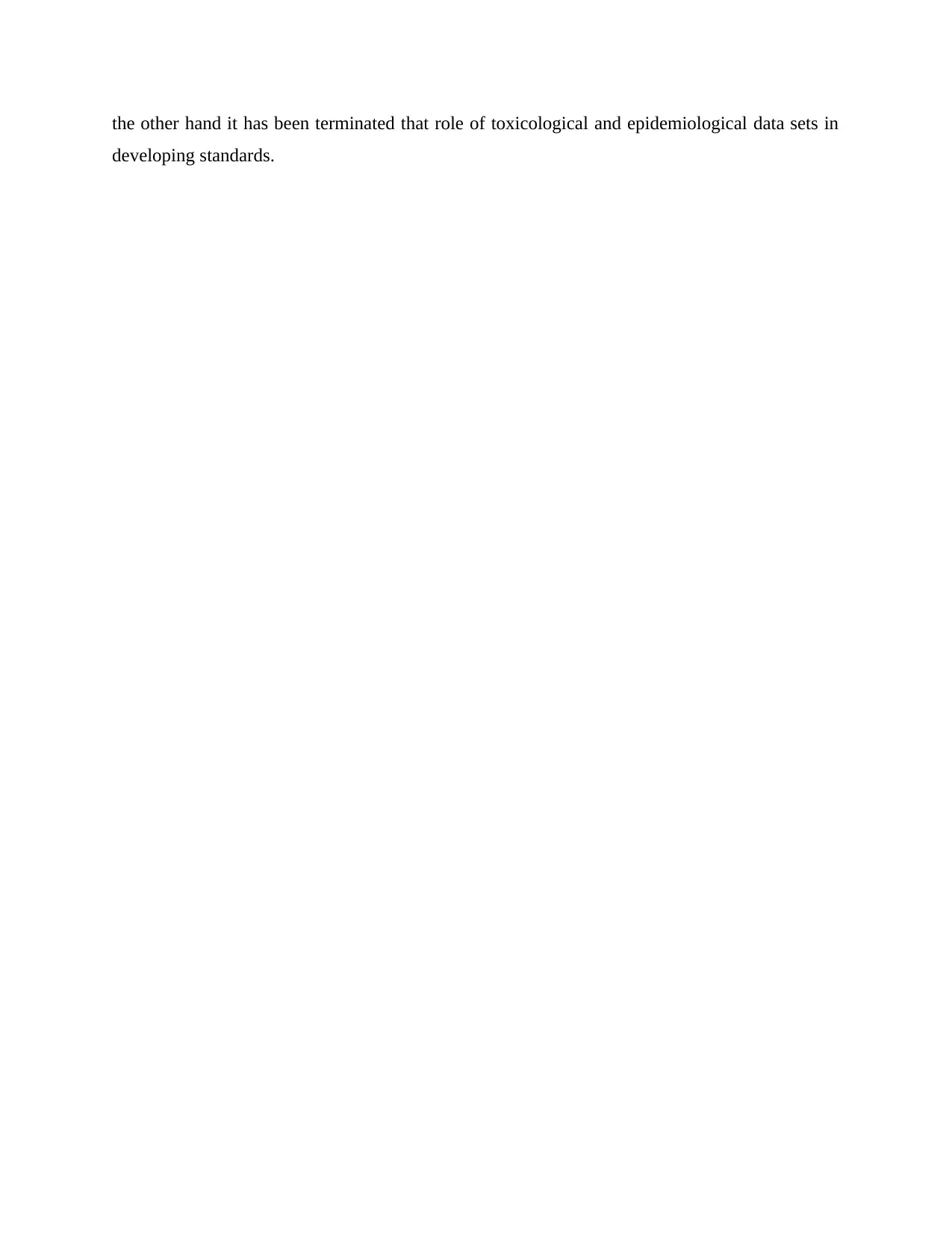
the other hand it has been terminated that role of toxicological and epidemiological data sets in
developing standards.
developing standards.
⊘ This is a preview!⊘
Do you want full access?
Subscribe today to unlock all pages.

Trusted by 1+ million students worldwide
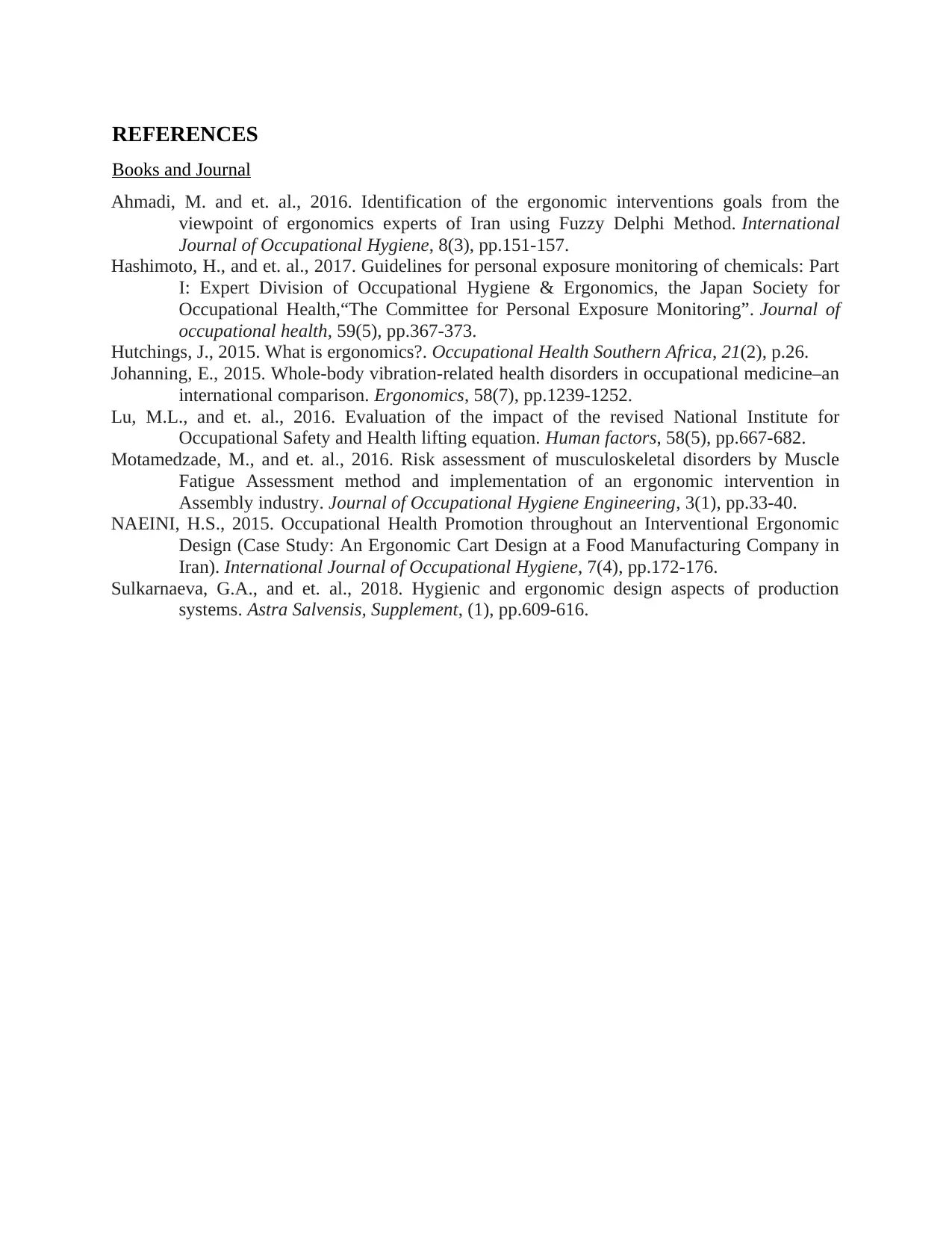
REFERENCES
Books and Journal
Ahmadi, M. and et. al., 2016. Identification of the ergonomic interventions goals from the
viewpoint of ergonomics experts of Iran using Fuzzy Delphi Method. International
Journal of Occupational Hygiene, 8(3), pp.151-157.
Hashimoto, H., and et. al., 2017. Guidelines for personal exposure monitoring of chemicals: Part
I: Expert Division of Occupational Hygiene & Ergonomics, the Japan Society for
Occupational Health,“The Committee for Personal Exposure Monitoring”. Journal of
occupational health, 59(5), pp.367-373.
Hutchings, J., 2015. What is ergonomics?. Occupational Health Southern Africa, 21(2), p.26.
Johanning, E., 2015. Whole-body vibration-related health disorders in occupational medicine–an
international comparison. Ergonomics, 58(7), pp.1239-1252.
Lu, M.L., and et. al., 2016. Evaluation of the impact of the revised National Institute for
Occupational Safety and Health lifting equation. Human factors, 58(5), pp.667-682.
Motamedzade, M., and et. al., 2016. Risk assessment of musculoskeletal disorders by Muscle
Fatigue Assessment method and implementation of an ergonomic intervention in
Assembly industry. Journal of Occupational Hygiene Engineering, 3(1), pp.33-40.
NAEINI, H.S., 2015. Occupational Health Promotion throughout an Interventional Ergonomic
Design (Case Study: An Ergonomic Cart Design at a Food Manufacturing Company in
Iran). International Journal of Occupational Hygiene, 7(4), pp.172-176.
Sulkarnaeva, G.A., and et. al., 2018. Hygienic and ergonomic design aspects of production
systems. Astra Salvensis, Supplement, (1), pp.609-616.
Books and Journal
Ahmadi, M. and et. al., 2016. Identification of the ergonomic interventions goals from the
viewpoint of ergonomics experts of Iran using Fuzzy Delphi Method. International
Journal of Occupational Hygiene, 8(3), pp.151-157.
Hashimoto, H., and et. al., 2017. Guidelines for personal exposure monitoring of chemicals: Part
I: Expert Division of Occupational Hygiene & Ergonomics, the Japan Society for
Occupational Health,“The Committee for Personal Exposure Monitoring”. Journal of
occupational health, 59(5), pp.367-373.
Hutchings, J., 2015. What is ergonomics?. Occupational Health Southern Africa, 21(2), p.26.
Johanning, E., 2015. Whole-body vibration-related health disorders in occupational medicine–an
international comparison. Ergonomics, 58(7), pp.1239-1252.
Lu, M.L., and et. al., 2016. Evaluation of the impact of the revised National Institute for
Occupational Safety and Health lifting equation. Human factors, 58(5), pp.667-682.
Motamedzade, M., and et. al., 2016. Risk assessment of musculoskeletal disorders by Muscle
Fatigue Assessment method and implementation of an ergonomic intervention in
Assembly industry. Journal of Occupational Hygiene Engineering, 3(1), pp.33-40.
NAEINI, H.S., 2015. Occupational Health Promotion throughout an Interventional Ergonomic
Design (Case Study: An Ergonomic Cart Design at a Food Manufacturing Company in
Iran). International Journal of Occupational Hygiene, 7(4), pp.172-176.
Sulkarnaeva, G.A., and et. al., 2018. Hygienic and ergonomic design aspects of production
systems. Astra Salvensis, Supplement, (1), pp.609-616.
1 out of 10
Related Documents
Your All-in-One AI-Powered Toolkit for Academic Success.
+13062052269
info@desklib.com
Available 24*7 on WhatsApp / Email
![[object Object]](/_next/static/media/star-bottom.7253800d.svg)
Unlock your academic potential
Copyright © 2020–2025 A2Z Services. All Rights Reserved. Developed and managed by ZUCOL.





